Construction and Application of Dynamic Threshold Model for Agricultural Drought Grades Based on Near-Infrared and Short-Wave Infrared Bands for Spring Maize
Abstract
1. Introduction
2. Materials and Methods
2.1. Study Area
2.2. Data
2.2.1. Remotely Sensed Data
2.2.2. Distribution Datasets for Spring Maize
2.2.3. Actual Disaster Records
2.2.4. Phenophase Observations
2.2.5. Yield Data
2.3. Methods
2.3.1. Construction of Drought Samples
2.3.2. Drought Threshold Curves
2.3.3. Daily Dynamic Thresholds and Its Validation
2.3.4. Maize Yield Analysis
3. Results
3.1. Dynamic Threshold Model for Agricultural Drought Grades
3.1.1. Determination of Daily Dynamic Thresholds for Different Drought Grades
3.1.2. Validation of Drought Grades
3.2. Analysis of Historical Drought Events Based on Dynamic Drought Thresholds of VWI
3.2.1. Drought Dynamics at a Typical Station
3.2.2. Spatial Evolution of Drought in Typical Drought Years
3.2.3. Impact of Drought on Spring Maize Yield
3.3. Distribution Characteristics of Drought Identified by VWI in 2000–2020
4. Discussion
5. Conclusions
Author Contributions
Funding
Data Availability Statement
Acknowledgments
Conflicts of Interest
References
- Wang, F.; Wang, C.Y.; Wu, D.R.; Yao, S.R.; Bai, Y.M.; Zhang, J.Q. Difference and cause analysis of drought characteristics during growth period between the corn belts of China and the United States in Past 30 Years. Chin. J. Agrometeor. 2018, 39, 398–410. [Google Scholar]
- Liu, X.; He, X.M.; You, S.C. Characteristics of agricultural meteorological disasters in China from 1976 to 2015. Chin. J. Agrometeor. 2017, 38, 481–487. [Google Scholar]
- Zhang, J.P.; He, Y.K.; Wang, J.; Zhao, Y.X.; Wang, C.Y. Impact simulation of drought at different growth stages on grain formation and yield of maize. Chin. J. Agrometeor. 2015, 36, 43–49. [Google Scholar]
- Wang, C.Y.; Lou, X.R.; Wang, J.L. Influence of agricultural meteorological disasters on output of crop in China. J. Nat. Disaster 2007, 16, 37–43. [Google Scholar]
- Seneviratne, S.I.; Zhang, X.; Adnan, M.; Badi, W.; Dereczynski, C.; Luca, A.D.; Ghosh, S.; Iskandar, I.; Kossin, J.; Lewis, S.; et al. Weather and Climate Extreme Events in a Changing Climate//IPCC Climate Change 2021: The Physical Science Basis; Cambridge University Press: Cambridge, MA, USA, 2021. [Google Scholar]
- Zhang, Y.D.; Wang, P.J.; Chen, Y.Y.; Yang, J.Y.; Wu, D.R.; Ma, Y.P.; Huo, Z.G.; Liu, S.X. Daily dynamic thresholds of different agricultural drought grades for summer maize based on the Vegetation Water Index. J. Hydrol. 2023, 625, 130070. [Google Scholar] [CrossRef]
- Wu, X.; Wang, P.J.; Huo, Z.G.; Wu, D.R.; Yang, J.Y. Crop Drought Identification Index for winter wheat based on evapotranspiration in the Huang-Huai-Hai Plain, China. Agric. Ecosyst. Environ. 2018, 263, 18–30. [Google Scholar] [CrossRef]
- Wu, X.; Wang, P.J.; Gong, Y.D.; Yang, J.Y. Analysis of drought identification and spatio-temporal characteristics for summer corn in Huang-Huai-Hai Plain in year of 1961–2015. Trans. Chin. Soc. Agric. Eng. 2019, 35, 189–199. [Google Scholar]
- Wu, X.; Wang, P.J.; Ma, Y.P.; Gong, Y.D.; Wu, D.R.; Yang, J.Y.; Huo, Z.G. Standardized relative humidity index can be used to identify agricultural drought for summer maize in the Huang-Huai-Hai Plain, China. Ecol. Indic. 2021, 131, 108222. [Google Scholar] [CrossRef]
- Wayne, C.P. Keeping track of crop moisture conditions, Nationwide: The new crop moisture index. Weatherwise 1968, 21, 156–161. [Google Scholar]
- Garen, D.C. Revised Surface-Water Supply Index for western United States. J. Water Resour. Plan. Manag. 1993, 119, 437–554. [Google Scholar] [CrossRef]
- Mckee, T.B.; Doesken, N.J.; Kleist, J. The relationship of drought frequency and duration to time scales. In Proceedings of the Eighth Conference on Applied Climatology, Anaheim, CA, USA, 17–22 January 1993. [Google Scholar]
- Akinremi, O.O.; Mcginn, S.M.; Barr, A.G. Evaluation of the Palmer Drought Index on the Canadian prairies. J. Clim. 2009, 9, 897–905. [Google Scholar] [CrossRef]
- Wu, R.J.; Shi, J.Q.; Guan, F.L.; Yao, S.R. Integrated index construction and zoning of drought risk: A case study of winter wheat area in Hebei Province. J. Nat. Disaster 2013, 22, 145–152. [Google Scholar]
- Rouse, J.; Haas, R.; Schell, J.; Deering, D. Monitoring Vegetation Systems in the Great Plains with ERTS; NASA Special Publication: Washington, DC, USA, 1974. [Google Scholar]
- Gao, B.-C. NDWI-A Normalized Difference Water Index for remote sensing of vegetation liquid water from space. Remote Sens. Environ. 1996, 58, 257–266. [Google Scholar] [CrossRef]
- McVicar, T.R.; Bierwirth, P.N. Rapidly assessing the 1997 drought in Papua New Guinea using composite AVHRR imagery. Int. J. Remote Sens. 2001, 22, 2109–2128. [Google Scholar] [CrossRef]
- Sandholt, I.; Rasmussen, K.; Andersen, J. A simple interpretation of the surface temperature/vegetation index space for assessment of surface moisture status. Remote Sens. Environ. 2002, 79, 213–224. [Google Scholar] [CrossRef]
- Su, Z.; Yacob, A.; Wen, J.; Roerink, G.; He, Y.B.; Gao, B.H.; Boogaard, H.; Diepen, C. Assessing relative soil moisture with remote sensing data: Theory, experimental validation, and application to drought monitoring over the North China Plain. Phys. Chem. 2003, 28, 89–101. [Google Scholar] [CrossRef]
- Brown, J.F.; Wardlow, B.D.; Tadesse, T.; Hayes, M.J.; Reed, B.C. The Vegetation Drought Response Index (VegDRI): A new integrated approach for monitoring drought stress in vegetation. GISci. Remote Sens. 2008, 45, 16–46. [Google Scholar] [CrossRef]
- Kogan, F.N. Global drought watch from space. Bull. Am. Meteor. Soc. 2010, 78, 67–69. [Google Scholar] [CrossRef]
- Peng, D.L.; Huang, J.F.; Cai, C.X.; Deng, R. Spatialization on monthly average air temperature in Xinjiang and the analysis of the result. J. Zhejiang Univ. (Sci. Ed.) 2007, 34, 580–584. [Google Scholar]
- Aghakouchak, A.; Farahmand, A.; Melton, F.S.; Teixeira, J.; Anderson, M.C.; Wardlow, B.D.; Hain, C.R. Remote sensing of drought: Progress, challenges and opportunities. Rev. Geophys. 2015, 53, 452–480. [Google Scholar] [CrossRef]
- Kalisa, W.; Zhang, J.H.; Igbawua, T.; Ujoh, F.; Ebohon, O.J.; Namugize, J.N.; Yao, F. Spatio-temporal analysis of drought and return periods over the East African region using Standardized Precipitation Index from 1920 to 2016. Agric. Water Manag. 2020, 237, 106195. [Google Scholar] [CrossRef]
- Cai, S.Y.; Zuo, D.P.; Wang, H.X.; Xu, Z.X.; Wang, G.Q.; Yang, H. Assessment of agricultural drought based on multi-source remote sensing data in a major grain producing area of Northwest China. Agric. Water Manag. 2023, 278, 108142. [Google Scholar] [CrossRef]
- Gao, B.-C.; Goetz, A. Extraction of dry leaf spectral features from reflectance spectra of green vegetation. Remote Sens. Environ. 1994, 47, 369–374. [Google Scholar] [CrossRef]
- Chen, D.; Huang, J.; Jackson, T. Vegetation water content estimation for corn and soybeans using spectral indices from MODIS near- and short-wave infrared bands. Remote Sens. Environ. 2005, 98, 225–236. [Google Scholar] [CrossRef]
- Gu, Y.; Brown, J.; Verdin, J.; Wardlow, B. A five-year analysis of MODIS NDVI and NDWI for grassland drought assessment over the central Great Plains of the United States. Geophys. Res. Lett. 2007, 34, 6. [Google Scholar] [CrossRef]
- Wolski, P.; Murray-Hudson, M.; Thito, K.; Cassidy, L. Keeping it simple: Monitoring flood extent in large data-poor wetlands using MODIS SWIR data. Int. J. Appl. Earth Obs. Geoinf. 2017, 57, 224–234. [Google Scholar] [CrossRef]
- Chen, Y.Y.; Wang, P.J.; Zhang, Y.D.; Yang, J.Y. Comparison of drought recognition of spring maize in Northern China based on 3 remote sensing indices. J. Appl. Meteor. Sci. 2022, 33, 466–476. [Google Scholar]
- Liu, X.L.; Qin, Z.H. Comparative analysis between NDWI and NDVI indices in regional drought monitoring. Remote Sens. Technol. Appl. 2007, 22, 608–612. [Google Scholar]
- Liu, Z.Y. Study on Comprehensive Drought Monitoring Index and Its Application Based on Multi-Source Data in Southwest China. Master’s Thesis, Southwest University, Chongqing, China, 2015. [Google Scholar]
- Yang, X.C.; Ming, B.; Tao, H.B.; Wang, P. Spatial distribution characteristics and impact on spring maize yield of drought in Northeast China. Chin. J. Eco-Agric. 2015, 23, 758–767. [Google Scholar]
- Yang, Y.; Qi, Y.; Zhao, H.; Ma, Y.H.; Zhu, D. Effects and evaluations of water stress on growth development and yield of maize during critical growthperiods in arid and semi-arid regions. J. Arid Meteor. 2022, 40, 1059–1067. [Google Scholar]
- Wang, L.Y.; Yuan, X. Two types of flash drought and their connections with seasonal drought. Adv. Atmos. Sci. 2018, 35, 1478–1490. [Google Scholar] [CrossRef]
- Ren, L.; Zhou, T.; Zhang, W. Attribution of the record-breaking heat event over Northeast Asia in summer 2018: The role of circulation. Environ. Res. Lett. 2020, 15, 054018. [Google Scholar] [CrossRef]
- Li, J.; Wang, Z.L.; Wu, X.S.; Zscheischler, J.; Guo, S.L.; Chen, X.H. A standardized index for assessing sub-monthly compound dry and hot conditions with application in China. Hydrol. Earth Syst. Sci. 2021, 25, 1587–1601. [Google Scholar] [CrossRef]
- Agutu, N.O.; Awange, J.L.; Zerihun, A.; Ndehedehe, C.E.; Kuhn, M.; Fukuda, Y. Assessing multi-satellite remote sensing, reanalysis, and land surface models’ products in characterizing agricultural drought in East Africa. Remote Sens. Environ. 2017, 194, 287–302. [Google Scholar] [CrossRef]
- Jurdao, S.; Yebra, M.; Guerschman, J.P.; Chuvieco, E. Regional estimation of woodland moisture content by inverting Radiative Transfer Models. Remote Sens. Environ. 2013, 132, 59–70. [Google Scholar] [CrossRef]
- Schaaf, C.B.; Gao, F.; Strahler, A.H.; Lucht, W.; Li, X.; Tsang, T.; Strugnell, N.C.; Zhang, X.Y.; Jin, Y.F.; Muller, J.; et al. First operational BRDF, albedo nadir reflectance products from MODIS. Remote Sens. Environ. 2002, 83, 135–148. [Google Scholar] [CrossRef]
- Luo, Y.C.; Zhang, Z.; Li, Z.Y.; Chen, Y.; Zhang, L.L.; Cao, J.; Tao, F.L. Identifying the spatiotemporal changes of annual harvesting areas for three staple crops in China by integrating multi-data sources. Environ. Res. Lett. 2020, 15, 074003. [Google Scholar] [CrossRef]
- National Meteorological Administration. Specification for Agrometeorological Observation (Volume I); China Meteorological Press: Beijing, China, 1993. [Google Scholar]
- Song, L.C. Yearbook of Meteorological Disasters in China (2016); China Meteorological Press: Beijing, China, 2017. [Google Scholar]
- Ritchie, S.W.; Hanway, J.J.; Benson, G.O. How a Corn Plant Develops; Special Report No. 48; Iowa State University: Ames, IA, USA, 1986. [Google Scholar]
- Li, Z.G.; Yang, P.; Tang, H.J.; Wu, W.B.; Chen, Z.X.; Liu, J.; Zhang, L.; Tan, J.Y.; Tang, P.Q. Trends of spring maize phenophases and spatio-temporal responses to temperature in three provinces of Northeast China during the past 20 years. Acta Ecol. Sin. 2013, 33, 5818–5827. [Google Scholar]
- Li, Y.L.; Gao, S.H. Analysis of water supply and demand for spring corn in China. Meteor. Mon. 2002, 2, 29–33. [Google Scholar]
- Chu, Z.; Guo, J.P. Effcets of climatic change on maize varieties distribution in the future of Northeast China. J. Appl. Meteor. Sci. 2018, 29, 165–176. [Google Scholar]
- Efron, B. Double exponential families and their use in generalized linear regression. J. Am. Stat. Assoc. 1986, 81, 709–721. [Google Scholar] [CrossRef]
- Fischer, A. A model for the seasonal variations of vegetation indices in coarse resolution data and its inversion to extract crop parameters. Remote Sens. Environ. 1994, 48, 220–230. [Google Scholar] [CrossRef]
- Kang, J.; Hou, X.H.; Liu, Z.; Gao, S.; Jia, K. Decision tree classification based on fitted phenology parameters from remotely sensed vegetation data. Trans. Chin. Soc. Agric. Eng. 2014, 30, 148–156. [Google Scholar]
- Jiang, L.X.; Li, X.F.; Zhu, H.X.; Gao, M.; Wang, Q.J.; Yan, P.; Gong, L.J.; Zhai, M.; Ji, Y.H.; Wang, P. Characteristics of combination of cold damage and drought during seedling period and its effects on maize yield in Heilongjang Province. Agric. Res. Arid Areas 2020, 38, 11. [Google Scholar]
- Song, L.C. Yearbook of Meteorological Disasters in China (2017); China Meteorological Press: Beijing, China, 2018. [Google Scholar]
- Song, L.C. Yearbook of Meteorological Disasters in China (2018); China Meteorological Press: Beijing, China, 2019. [Google Scholar]
- Song, L.C. Yearbook of Meteorological Disasters in China (2020); China Meteorological Press: Beijing, China, 2021. [Google Scholar]
- Zhang, X.; Chen, N.C.; Li, J.Z.; Chen, Z.H.; Dev, N. Multi-sensor integrated framework and index for agricultural drought monitoring. Remote Sens. Environ. 2017, 188, 141–163. [Google Scholar] [CrossRef]
- Wang, J.; Yang, X.G.; Li, Y.; Liu, Z.J.; Zhang, X.Y. Changes of China agricultural climate resources under the background of global climate change. VI. Change characteristics of precipitation resource and its possible effect on maize production in Sanjiang Plain of Heilongjiang Province. Chin. J. Appl. Ecol. 2011, 22, 1511–1522. [Google Scholar]
- Li, C.R.; You, S.C.; Wu, Y.F. Drought characteristics and dominant meteorological factors drivingdrought in spring maize growing season in northeast China. Trans. Chin. Soc. Agric. Eng. 2020, 36, 97–106. [Google Scholar]
- Judge, J.; Liu, P.-W.; Monsiváis-Huertero, A.; Bongiovanni, T.; Chakrabarti, S.; Steele-Dunne, S.C.; Preston, D.; Allen, S.; Bermejo, J.P.; Rush, P.; et al. Impact of vegetation water content information on soil moisture retrievals in agricultural regions: An analysis based on the SMAPVEX16-MicroWEX dataset. Remote Sens. Environ. 2021, 265, 112623. [Google Scholar] [CrossRef]
- Luna, D.A.; Pottier, J.; Picon-Cochard, C. Variability and drivers of grassland sensitivity to drought at different timescales using satellite image time series. Agric. For. Meteorol. 2023, 331, 109325. [Google Scholar] [CrossRef]
- Liu, H.; Liu, R.G.; Liu, S.Y. Review of drought monitoring by Remote Sensing. J. Geoinf. Sci. 2012, 14, 232–239. [Google Scholar] [CrossRef]
- Ma, S.Q.; Wang, Q.; Chen, F.T.; Xu, L.P.; Zhang, T.L.; Yu, H.; Ji, L.L. Impact of spring maize seeding growth on yield and assessment models ofproduction cut under background of spring drought. Trans. Chin. Soc. Agric. Eng. 2015, 31, 171–179. [Google Scholar]
- Ma, X.G.; Li, N.; Zhou, B.; Li, J.; Sun, K.; Liu, J.; Zuo, Z. Study on the effect of drought on grain yield in Fuxin. J. Catastrophol. 2019, 34, 139–144. [Google Scholar]
- Okpara, J.N.; Afiesimama, E.A.; Anuforom, A.C.; Owino, A.; Ogunjobi, K.O. The applicability of Standardized Precipitation Index: Drought characterization for early warning system and weather index insurance in West Africa. Nat. Hazards 2017, 89, 555–583. [Google Scholar] [CrossRef]
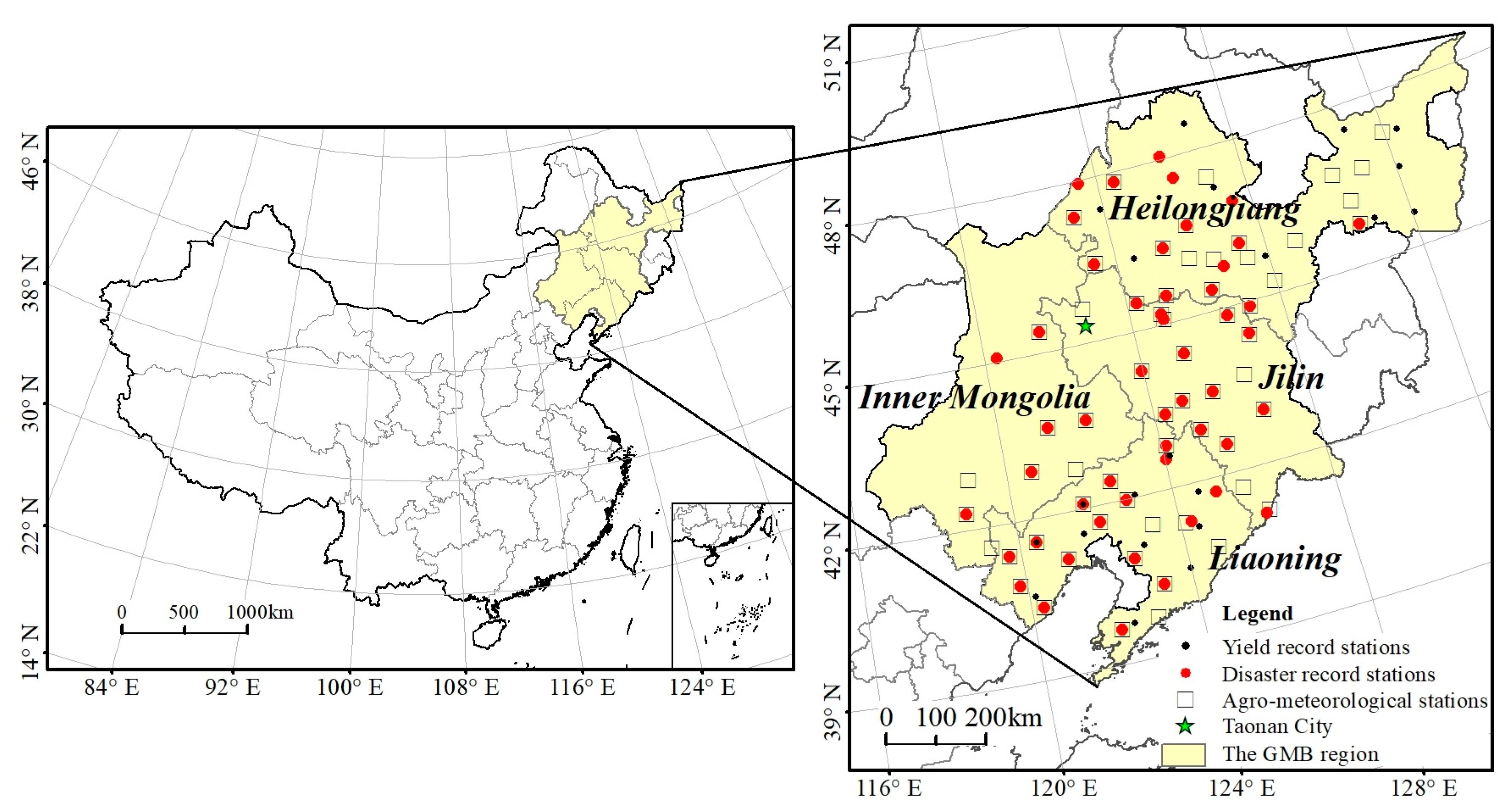


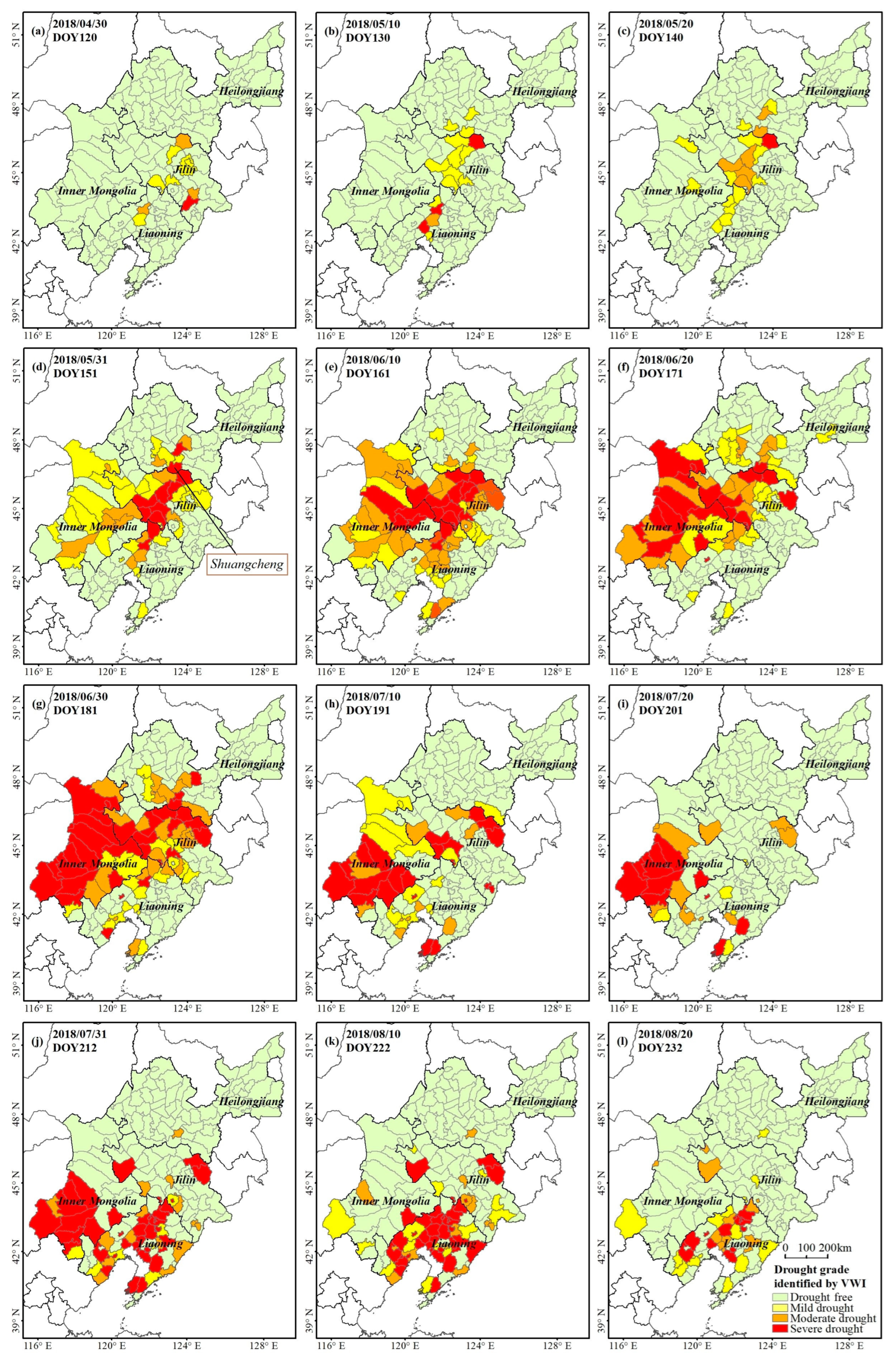
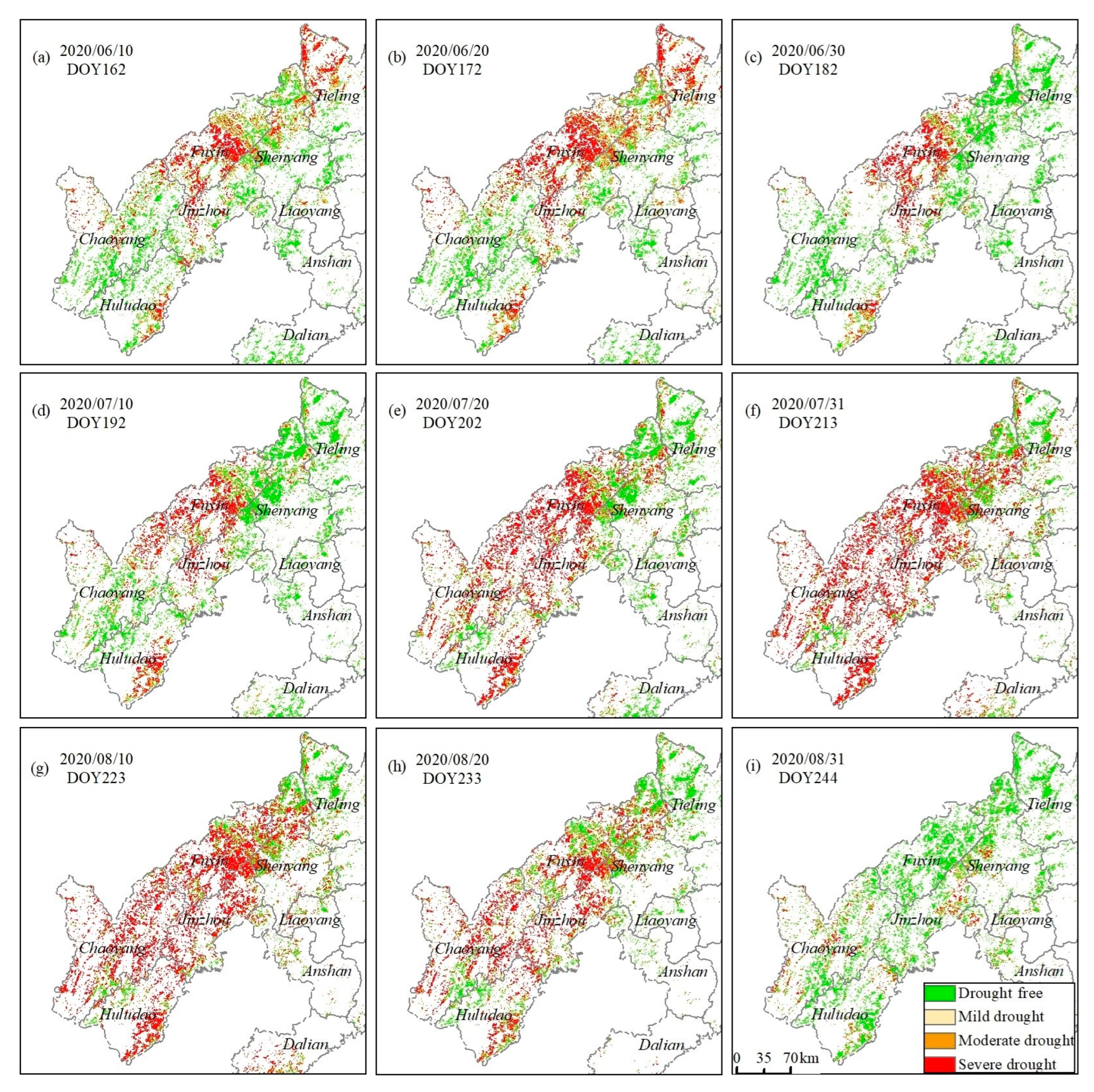
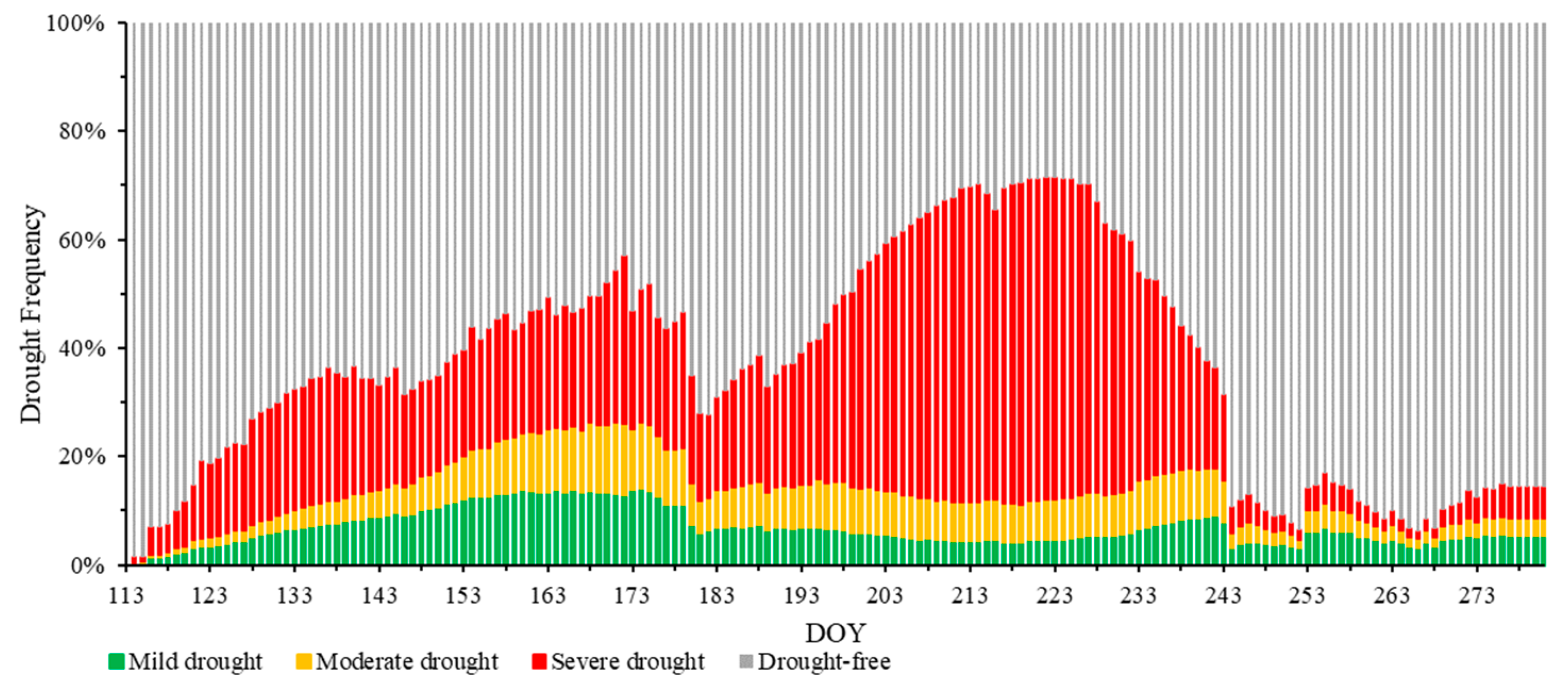
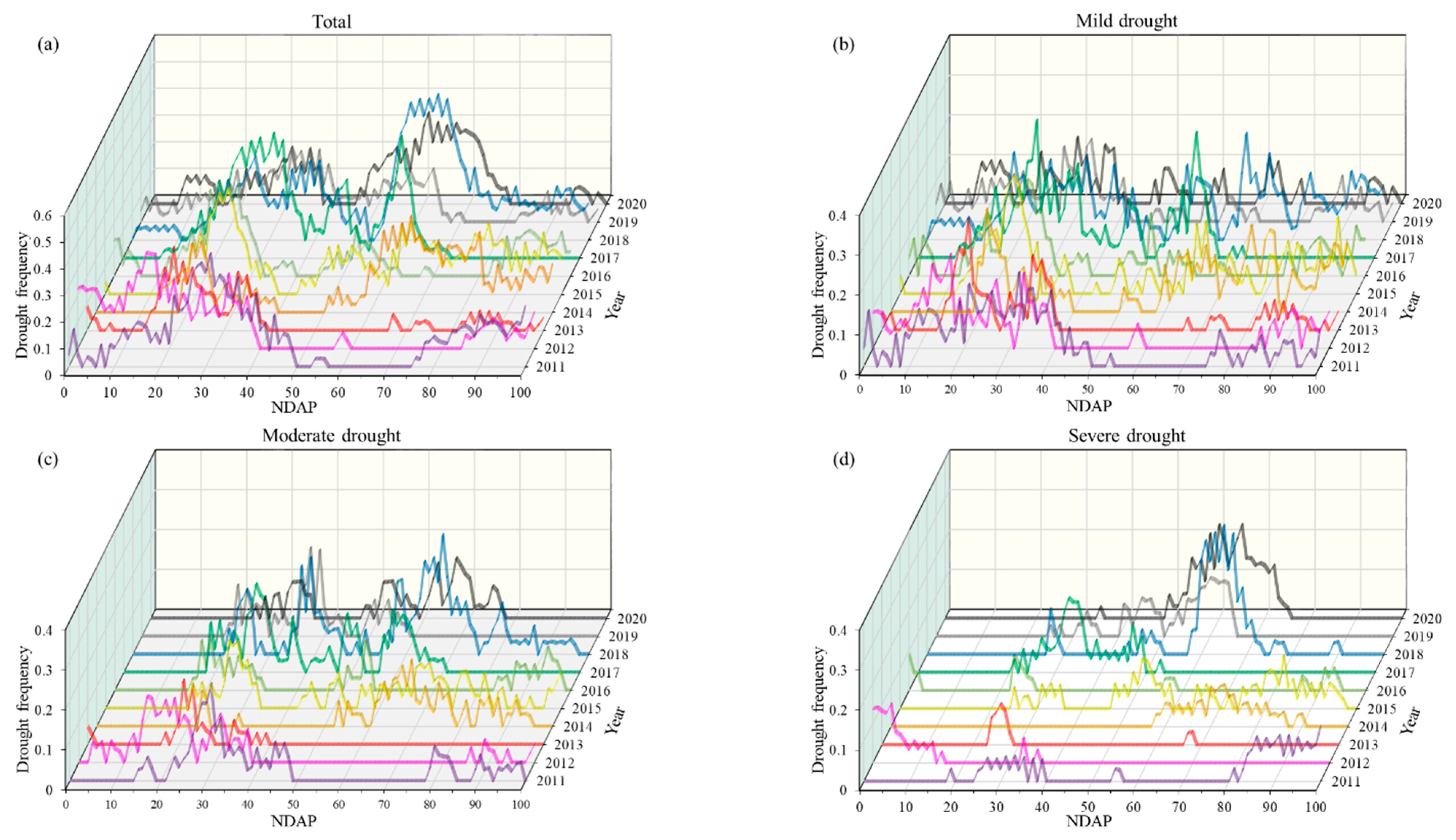
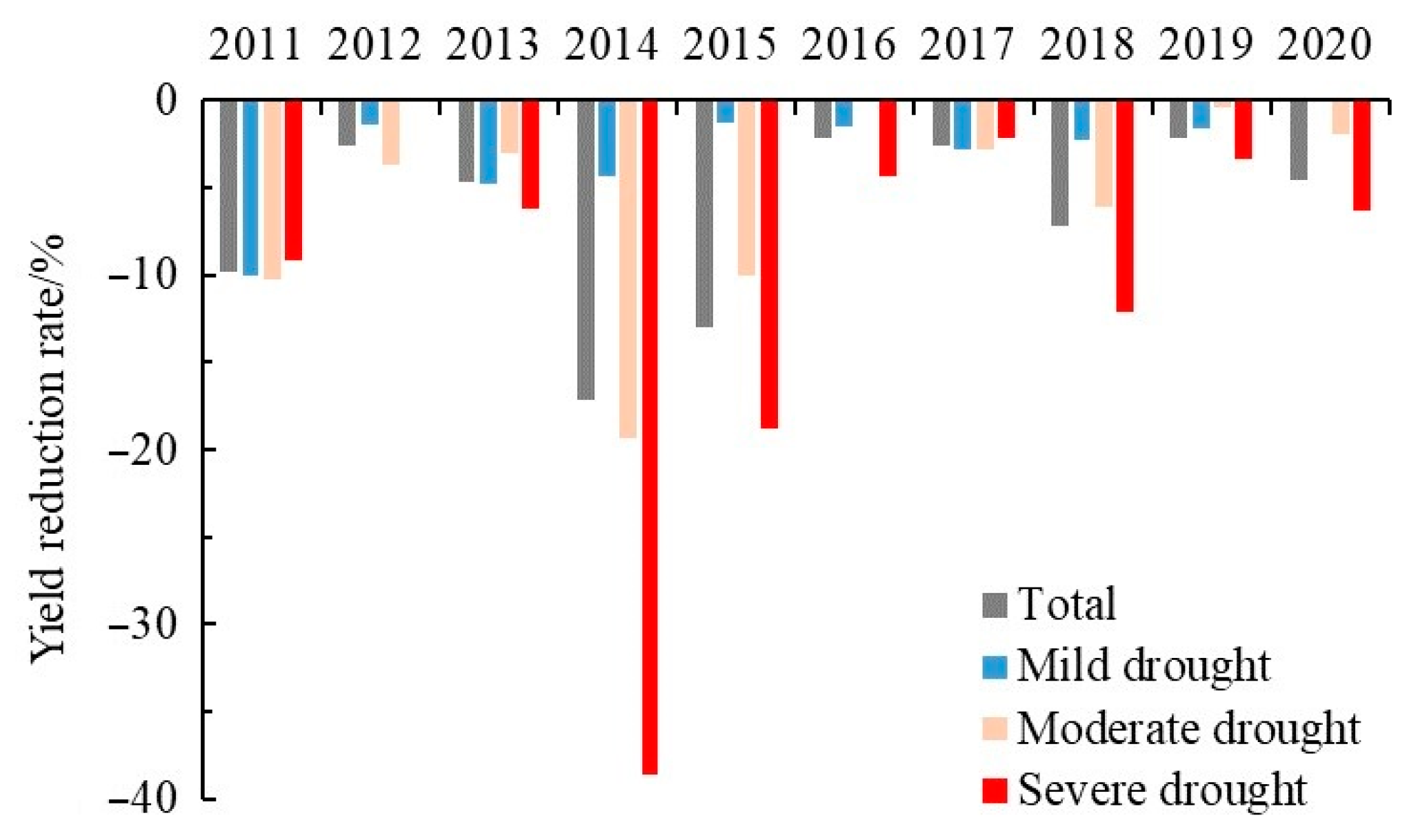
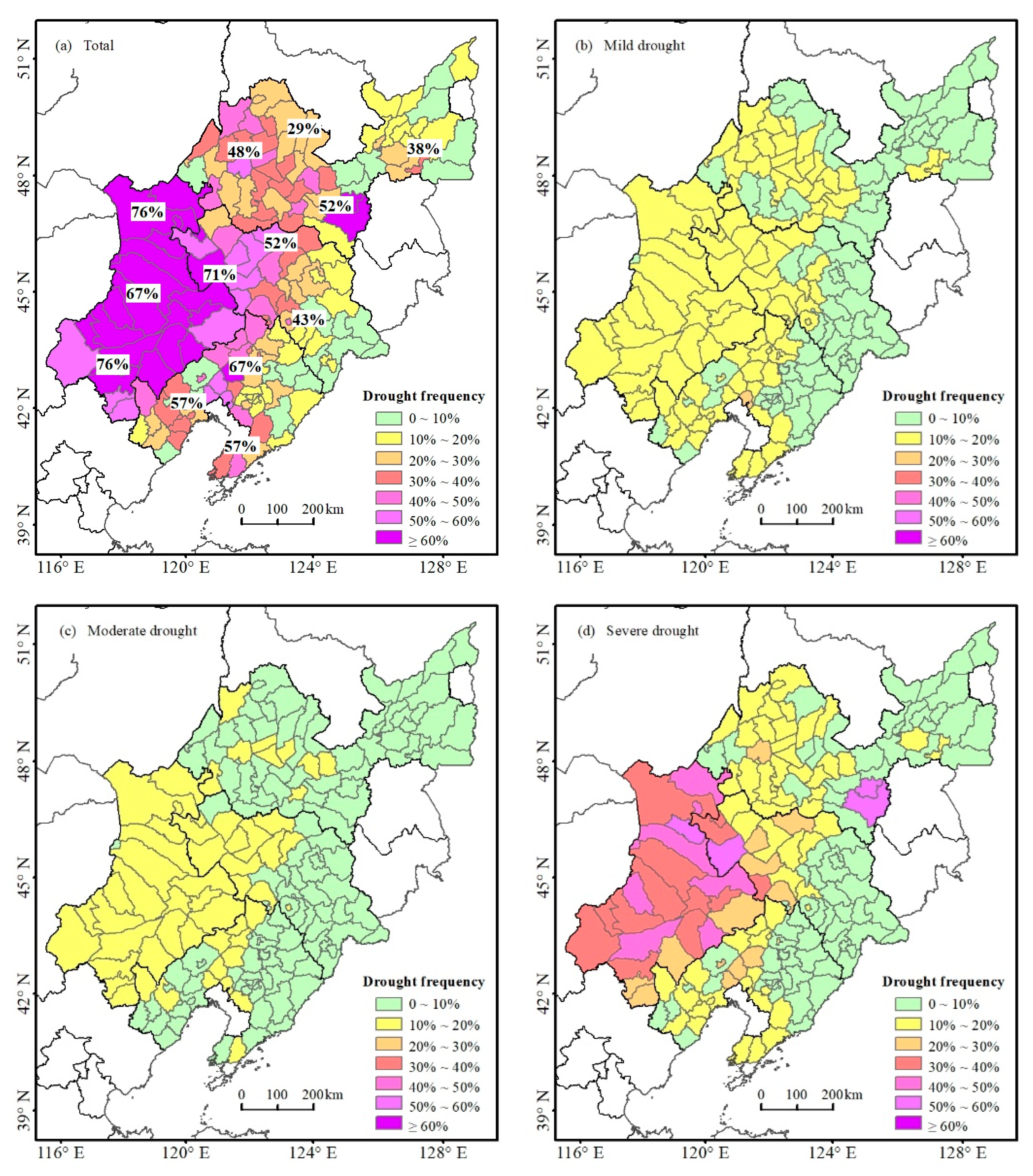
| Drought Grade | Drought Threshold |
|---|---|
| Drought free | |
| Mild drought | |
| Moderate drought | |
| Severe drought |
| Drought Grade | R2 | a | b | c | d |
|---|---|---|---|---|---|
| Drought free | 0.91 | 36.60 | 11.24 | 95.74 | 11.15 |
| Mild drought | 0.91 | 39.46 | 10.15 | 93.35 | 11.07 |
| Moderate drought | 0.93 | 41.15 | 10.15 | 91.37 | 11.16 |
| Severe drought | 0.96 | 44.08 | 9.76 | 89.56 | 11.49 |
| Drought Grade | Accuracy of Validation | Number of Drought Samples | |
|---|---|---|---|
| Complete Correspondence | Within One Grade | ||
| Total | 84.6% | 96.2% | 78 |
| Mild drought | 93.8% | 100.0% | 16 |
| Moderate drought | 76.3% | 94.7% | 38 |
| Severe drought | 91.7% | 95.8% | 24 |
Disclaimer/Publisher’s Note: The statements, opinions and data contained in all publications are solely those of the individual author(s) and contributor(s) and not of MDPI and/or the editor(s). MDPI and/or the editor(s) disclaim responsibility for any injury to people or property resulting from any ideas, methods, instructions or products referred to in the content. |
© 2024 by the authors. Licensee MDPI, Basel, Switzerland. This article is an open access article distributed under the terms and conditions of the Creative Commons Attribution (CC BY) license (https://creativecommons.org/licenses/by/4.0/).
Share and Cite
Wu, X.; Wang, P.; Gong, Y.; Zhang, Y.; Wang, Q.; Li, Y.; Guo, J.; Han, S. Construction and Application of Dynamic Threshold Model for Agricultural Drought Grades Based on Near-Infrared and Short-Wave Infrared Bands for Spring Maize. Remote Sens. 2024, 16, 3260. https://doi.org/10.3390/rs16173260
Wu X, Wang P, Gong Y, Zhang Y, Wang Q, Li Y, Guo J, Han S. Construction and Application of Dynamic Threshold Model for Agricultural Drought Grades Based on Near-Infrared and Short-Wave Infrared Bands for Spring Maize. Remote Sensing. 2024; 16(17):3260. https://doi.org/10.3390/rs16173260
Chicago/Turabian StyleWu, Xia, Peijuan Wang, Yanduo Gong, Yuanda Zhang, Qi Wang, Yang Li, Jianping Guo, and Shuxin Han. 2024. "Construction and Application of Dynamic Threshold Model for Agricultural Drought Grades Based on Near-Infrared and Short-Wave Infrared Bands for Spring Maize" Remote Sensing 16, no. 17: 3260. https://doi.org/10.3390/rs16173260
APA StyleWu, X., Wang, P., Gong, Y., Zhang, Y., Wang, Q., Li, Y., Guo, J., & Han, S. (2024). Construction and Application of Dynamic Threshold Model for Agricultural Drought Grades Based on Near-Infrared and Short-Wave Infrared Bands for Spring Maize. Remote Sensing, 16(17), 3260. https://doi.org/10.3390/rs16173260












